| Pages:
1
2 |
Keras
National Hazard
   
Posts: 766
Registered: 20-8-2018
Location: (48, 2)
Member Is Offline
|
|
Carbon disulfide synthesis (alternative routes)
Hi there,
As we all know, CS2 is more or less available, but is not cheap (€ 60 for 250 ml, that's about $70).
I’ve seen several videos and also here a former thread about syntesizing CS2, but they all seem to follow “the hard way”, namely
blowing sulphur gas over coal at an extremely hot temperature.
Nevertheless, digging further into it, I found at least two other routes documented in the ACS archives. The first one entails the use of methane and
H2S over silica gel at around 700 °C, which might not be much handier than the “traditional” way. The last one, on the other hand,
involves bubbling CO into liquid sulphur mixed with fine silica powder at 400 °C – which seems much easier to do, at least on paper. Of course,
I’m well aware of CO insidious and very acute toxicity, so I was just wondering if someone had already inquired into these alternative routes.
That's just out of sheer curiosity. I prefer to cough up 70 bucks than risk my life. :p
[Edited on 31-3-2019 by Keras]
[Edited on 31-3-2019 by Keras]
[Edited on 31-3-2019 by Keras]
|
|
|
XeonTheMGPony
International Hazard
    
Posts: 1636
Registered: 5-1-2016
Member Is Offline
Mood: No Mood
|
|
less ye plan to make it by the ton there is minimal risk providing one is competent enough to cook soup.
|
|
|
BromicAcid
International Hazard
    
Posts: 3227
Registered: 13-7-2003
Location: Wisconsin
Member Is Offline
Mood: Rock n' Roll
|
|
Digging through the patent literature one of the methods that popped out to me was the reaction of hydrocarbons, specifically propane with sulfur.
Advantage being that propane would be OTC. Disadvantage being the large amount of H2S created as a byproduct. If you need just small
amounts look into thermal decomposition of thiuram sulfides as some do have OTC applications.
[Edited on 3/31/2019 by BromicAcid]
|
|
|
Keras
National Hazard
   
Posts: 766
Registered: 20-8-2018
Location: (48, 2)
Member Is Offline
|
|
I work outdoors when I have to deal with toxic gas anyways (even NO2).
Quote: Originally posted by BromicAcid  | Digging through the patent literature one of the methods that popped out to me was the reaction of hydrocarbons, specifically propane with sulfur.
Advantage being that propane would be OTC. Disadvantage being the large amount of H2S created as a byproduct. If you need just small
amounts look into thermal decomposition of thiuram sulfides as some do have OTC applications.
[Edited on 3/31/2019 by BromicAcid] |
Propane or butane are certainly very easy to get one’s hand on. But thiuram sulphides? Could you be more specific? I see they're use either a
fungicide or to fight alcoholism (like the inky cap). In neither of those applications it seems easy to obtain…
[Edited on 31-3-2019 by Keras]
[Edited on 31-3-2019 by Keras]
|
|
|
12thealchemist
Hazard to Others
  
Posts: 181
Registered: 1-1-2014
Location: The Isle of Albion
Member Is Offline
Mood: Rare and Earthy
|
|
I went through Reaxys a few months ago and compiled this:
Attachment: Potential syntheses of CS2.pdf (107kB)
This file has been downloaded 870 times
I stripped out all C + S syntheses, and any ridiculous or unfriendly (to the hobby chemist, eg complex organic molecules) syntheses
|
|
|
Keras
National Hazard
   
Posts: 766
Registered: 20-8-2018
Location: (48, 2)
Member Is Offline
|
|
Thanks a bunch for that! I shall look into this tomorrow.
|
|
|
wg48temp9
National Hazard
   
Posts: 761
Registered: 30-12-2018
Location: not so United Kingdom
Member Is Offline
|
|
Quote: Originally posted by 12thealchemist  | I went through Reaxys a few months ago and compiled this:
I stripped out all C + S syntheses, and any ridiculous or unfriendly (to the hobby chemist, eg complex organic molecules) syntheses
|
There are some apparently simple methods there that use OTC reagents except for the CCl4 for example With S, iron ~(or aluminium or copper) in
tetrachloromethane, at 120°C.
So apart from the steel pressure bomb to heat the CCl4 to 120C what if any are the other problems?
I am wg48 but not on my usual pc hence the temp handle.
Thank goodness for Fleming and the fungi.
Old codger' lives matters, wear a mask and help save them.
Be aware of demagoguery, keep your frontal lobes fully engaged.
I don't know who invented mRNA vaccines but they should get a fancy medal and I hope they made a shed load of money from it.
|
|
|
BromicAcid
International Hazard
    
Posts: 3227
Registered: 13-7-2003
Location: Wisconsin
Member Is Offline
Mood: Rock n' Roll
|
|
There are whole mess of thiuram monosulfide and disulfides. Fungicides are the main use hence I mentioned OTC. I have seen them in dusting powders
at various times for gardening but usually as now more than 10%, hence me mentioning small amounts. Most of the thiuram compounds I have run across
are thermally unstable and at reasonable (100-250°C) temperatures undergo thermal decomposition to yield thioureas and carbon disulfide which
distills out of the reaction mixture.
|
|
|
Assured Fish
Hazard to Others
  
Posts: 319
Registered: 31-8-2015
Location: Noo Z Land
Member Is Offline
Mood: Misanthropic
|
|
There is a theoretical method starting from thiocyanate that could work.
It has been discussed in a previous thread, and another thread discussing the percyanic acid compound:
http://www.sciencemadness.org/talk/viewthread.php?tid=103650...
http://www.sciencemadness.org/talk/viewthread.php?tid=27676#...
It begins with the preparation of iso perthiocyanic acid, which involves treating a thiocyanate salt with an acid with a concentration over 40%.
3HCNS = HCN + H2C2N2S3
I have done this before and have a few grams of the supposed perthiocyanic acid sitting in a mason jar.
![20190401_170232[1].jpg - 1.9MB](https://www.sciencemadness.org/whisper/files.php?pid=607065&aid=74738)
Alas this stuff gives off nitrous oxide whenever i open the jar, i believe it decomposes if the acid is too concentrated as i also observed large
copious amounts of NO2 being given off during a few test runs to make it.
Its likely a small residual amount of acid is still present on this sample and when its exposed to the air, moisture gets in contact and causes the
decomposition.
This stuff was made using ammonium thiocyanate and nitric acid, the exact yield of which i cannot say as its the collection of multiple small test
tube scale experiments.
All I can say is that its rather difficult to filter, and can stain glassware if not cleaned off within a day or so.
Other than that though its very easy to make.
From the iso perthiocyanic acid it would be as simple as setting up a 3 neck round bottom flask in an oil bath with a still head and condenser in one
adapter, and a thermometer in the other reaching down into the bottom of the flask and an inlet tube to gas the system with a steady flow of nitrogen
or argon.
The oil bath can then be heated up to 180*C to 200*C and then the distillate collected, which can then be washed with water and redistilled hopefully
collecting something at around 46*C.
I would run this myself but i dont want to do it in my current residence as preparing a highly volatile somewhat toxic, extremely flammable liquid
that i cannot store is quite a dangerous exercise.
Sufficiently advanced science is indistinguishable from madness.
|
|
|
Keras
National Hazard
   
Posts: 766
Registered: 20-8-2018
Location: (48, 2)
Member Is Offline
|
|
Quote: Originally posted by Assured Fish  | There is a theoretical method starting from thiocyanate that could work.
It begins with the preparation of iso perthiocyanic acid, which involves treating a thiocyanate salt with an acid with a concentration over 40%.
3HCNS → HCN + H2C2N2S3
I have done this before and have a few grams of the supposed perthiocyanic acid sitting in a mason jar. |
I was wondering about this article: F. Cataldo, Y. Keheyan: About a new class of inorganic polymers: the polythiocyanogens, in Polyhedron 21 (2002),
especially: "It is shown that all the pseudohalogens belonging to the series of sulfur dicyanide Sy (CN)2 or thiocyanogens
polymerise very easily in the dry state, under moderate heating to produce a series of brick-red or orange solids known as polythiocyanogens with the
general formula (Sy (CN)2)x with y an integer 1, 2, 3, 4."
Could it be what you obtained?
[Edited on 1-4-2019 by Keras]
|
|
|
Keras
National Hazard
   
Posts: 766
Registered: 20-8-2018
Location: (48, 2)
Member Is Offline
|
|
Quote: Originally posted by 12thealchemist  | I went through Reaxys a few months ago and compiled this:
I stripped out all C + S syntheses, and any ridiculous or unfriendly (to the hobby chemist, eg complex organic molecules) syntheses
|
Ok, I don’t have Reaxys and seem to have only limited access to Gmelin; couldn't find most of them, but the one using carbon tetrabromide seems
interesting. However, until my batch of potassium bromide arrives, I only get access to pure iodine. I wonder if that could work with carbon
tetraiodide…
[Edited on 1-4-2019 by Keras]
|
|
|
Assured Fish
Hazard to Others
  
Posts: 319
Registered: 31-8-2015
Location: Noo Z Land
Member Is Offline
Mood: Misanthropic
|
|
| Quote: |
Could it be what you obtained?
|
After reading through that paper, i can safely say that i very much doubt that is at all what ive obtained, or that those polymers are what others
have obtained before me.
For starters the reaction conditions used for the preparation of all those polymers were anhydrous, while they were washed with water in the work up
in a few examples.
The conditions described don't even come close to what ive recreated.
Their paper discusses preparing compounds such as sulfur dicyanide which would require the thiocyanate to be reduced.
It just wouldn't make any sense.
The compound iso-perthiocyanic acid is a a differnet compound all together with a somewhat unknown structure.
https://sci-hub.tw/https://link.springer.com/article/10.1007...
Actually having just found this ref, i should probably try to test this given that ive got some sodium nitrite on hand.
There are a few papers on the subject but to get any results with google i found that using the name isoperthiocyanic acid yields better results than
iso-perthiocyanic acid.
| Quote: |
I only get access to pure iodine. I wonder if that could work with carbon tetraiodide
|
This is not a good idea, i mean in theory you could attempt free radical halogenation of iodoform but ive never seen an example of this occurring
which may be to do with carbon tetraiodide being rather unstable and the conditions required for free radical halogenation are both thermal and
photochemical which the wiki states decomposes carbon tetraiodide back to iodoform and iodine.
Meaning you may end up with a very small amount of CI4 but the equalibrium lies heavily on the iodoform side.
https://en.wikipedia.org/wiki/Carbon_tetraiodide
Metasynthesis is instead the go to approach for preparing CI4, but even then its very expensive to make.
CCl4 on the other hand has been prepared on the forum:
http://www.sciencemadness.org/talk/viewthread.php?tid=14927
That thread should be moved to prepublications.
Sufficiently advanced science is indistinguishable from madness.
|
|
|
Keras
National Hazard
   
Posts: 766
Registered: 20-8-2018
Location: (48, 2)
Member Is Offline
|
|
Coming back to CS2, I found that it could also be produced by decomposition of thiourea at 230 °C.
Ref: Wang, Zerong Daniel; Hysmith, Meagan; Quintana, Perla Cristina: Theoretical study on the formation of carbon disulfide and ammonia from
thermal decomposition products of thiourea (DOI:10.1142/S0219633614500229).
Thiourea is real cheap, so that could be a really convenient way to get cheap CS2!
[Edited on 2-4-2019 by Keras]
|
|
|
clearly_not_atara
International Hazard
    
Posts: 2691
Registered: 3-11-2013
Member Is Offline
Mood: Big
|
|
The most interesting one in here IMHO is the method using CuCN + S + heat, and the very similar Fe(SCN)3 + heat; if I can guess that the reaction of
sulfur with a transition metal cyanide at a high enough temperature generates (perhaps transiently) the thiocyanate, they are the same: thermal
decomposition of a transition metal thiocyanate. This gives a lot of possibilities for the thiocyanate and in particular CuCN can be prepared from OTC
(and safe) ferr[oi]cyanides.
The similar methods using pyrolysis of thiourea are more likely to produce other gases as well (H3N might react with CS2 on cooling, and any formation
of H2S is bad), while CS2, S2 and N2 should be the only significant volatile products from pyrolysing a metal thiocyanate (cyanogen and thiocyanogen
should not be stable at these temperatures). (Transition metal thiocyanates should have lower decomposition temperatures than other thiocyanates.)
[Edited on 2-4-2019 by clearly_not_atara]
[Edited on 04-20-1969 by clearly_not_atara]
|
|
|
Keras
National Hazard
   
Posts: 766
Registered: 20-8-2018
Location: (48, 2)
Member Is Offline
|
|
Quote: Originally posted by Keras  | Coming back to CS2, I found that it could also be produced by decomposition of thiourea at 230 °C.
Ref: Wang, Zerong Daniel; Hysmith, Meagan; Quintana, Perla Cristina: Theoretical study on the formation of carbon disulfide and ammonia from
thermal decomposition products of thiourea (DOI:10.1142/S0219633614500229).
|
I’m sort of resurrecting or unearthing this thread because I would like to try this method. Since CS₂ auto-ignites at around 200 °C in air, the
whole setup would be conducted under inert (argon) atmosphere. Planned setup is this: two-neck bottom flask, one neck fitted with an argon supply,
second neck connected to a distillation apparatus, whose exit leads to two cascaded Drechsel bottles, the first being filled with mineral oil to avoid
air getting in, the second with 10% bleach, since I read thermal decomposition of thiourea can also produce a small amount of HCN, even though not
much is evolved at the planned temperature (circa 220 °C).
The RBF is flushed with Ar, then heated, with excess air bubbling out through the Drechsel bottles.
I quote: The main gaseous products of thiourea in pure Ar atmosphere between 182 and 330°C are found by TG-FTIR to be carbon disulfide (CS₂)
and ammonia (NH₃) indicating decomposition of neighbouring thiourea molecules in the melt: 2 SC(NH₂)₂ (l) → CS₂(g) + 2 NH₃(g) + H₂NCN(l)
Evolution of other gaseous species as cyanamide (H₂NCN), hydrogen cyanide (HCN), carbon dioxide (CO₂), and carbonyl sulfide (COS) are observed
only at temperatures higher than 500°C.
That gives quite a margin of security, but one never knows. Everything is of course going to be done outside, and a multi-metre gas tube will be used
to exhaust the gases out of the second Drechsel bottle far away from the setup.
Temperature should be stabilised around 220 °C, which gives the greatest output of CS₂.
Of course, dismantling the apparatus will be somewhat tricky, but I plan to do it by reopening the Ar source, disconnecting the stillhead, then
placing a stopper on the flask and stopping the Ar flow, until the flask is cold enough to be opened without risking residual CS₂ self ignition.
Any comments on this blueprint?
EDIT: Since the other gas evolved is ammonia, using bleach might not be a good idea (chloramines formation)?
[Edited on 15-5-2021 by Keras]
|
|
|
Jenks
Hazard to Others
  
Posts: 130
Registered: 1-12-2019
Member Is Offline
|
|
Quote: Originally posted by Keras  | | Since CS₂ auto-ignites at around 200 °C in air, the whole setup would be conducted under inert (argon) atmosphere. |
According to wikipedia the auto-ignition temperature is 102C. A very old demo is to ignite carbon disulfide with steam or a boiling-hot surface. The
other old demo was to pour a mixture of carbon disulfide and carbon tetrachloride into one's hand and set fire to it. Apparently the low heat of
combustion of carbon disulfide, along with the cooling from evaporation of the tetrachloride, prevented being burned.
|
|
|
Keras
National Hazard
   
Posts: 766
Registered: 20-8-2018
Location: (48, 2)
Member Is Offline
|
|
Oops. That’s lower than I suspected. The paper says red flames begin to flash at the surface of the liquid (when heated in air) when the temp
reaches 200 °C, but that of course is the threshold for CS₂ formation.
Quote: Originally posted by Jenks  |
The other old demo was to pour a mixture of carbon disulfide and carbon tetrachloride into one's hand and set fire to it. Apparently the low heat of
combustion of carbon disulfide, along with the cooling from evaporation of the tetrachloride, prevented being burned. |
Didn't know about that one. My main problem was the rather extended explosive range of CS₂. But if operated under argon, everything should go
smoothly.
Also, I was thinking about inserting another Drechsel bottle between the paraffin and the bleach one, this time filled with HCl in order to trap the
ammonia and avoid it reaching the bleach.
|
|
|
S.C. Wack
bibliomaster
    
Posts: 2419
Registered: 7-5-2004
Location: Cornworld, Central USA
Member Is Offline
Mood: Enhanced
|
|
There are alarming neurological reports in some of the earliest industrial hygiene work for CS2 as well. (BTW it's also responsible for the almost
complete 35-year gap in cannabinoid chemistry after CBN was first purified, killing one of the discoverers by fire)
I'd want to ask someone who "found by TG-FTIR" CS2 if they think it's feasible to produce it in that way (I'm guessing no). If pyrite or S and C is
too big of a hassle and H2S is OK, wouldn't it be sensible to generate it from methane/ethylene/acetylene and S/pyrite. (strong cooling of the exit
gas would be needed)
[Edited on 15-5-2021 by S.C. Wack]
|
|
|
macckone
International Hazard
    
Posts: 2159
Registered: 1-3-2013
Location: Over a mile high
Member Is Offline
Mood: Electrical
|
|
Bryce, W. A.; Hinshelwood, Cyril (1949). 707. The reaction between paraffin hydrocarbons and sulphur vapour. Journal of the Chemical Society
(Resumed), (), 3379–. doi:10.1039/JR9490003379
This produces a lot of crud but the three main products are hydrogen sulfide, unsaturated hydrocarbons and carbon disulfide.
Bubbling acetylene vapor through molten sulfur seems like a viable method. Acetylene can be easily produce from calcium carbide. This will reduce
the amount of hydrogen sulfide that is produced. 77% of the product is carbon disulfide at 325C. I would expect you could add a catalyst and increase
the reaction rate. The paper below tried iron and iodine with little effect. Silicate might help. This is one of those research topics.
http://www.sciencemadness.org/talk/files.php?pid=153376&...
Regardless of method flammability is an issue. I would recommend carbon dioxide as an inert gas as it is easy to produce and far cheaper for the home
chemist than argon.
|
|
|
Keras
National Hazard
   
Posts: 766
Registered: 20-8-2018
Location: (48, 2)
Member Is Offline
|
|
Quote: Originally posted by macckone  | Bryce, W. A.; Hinshelwood, Cyril (1949). 707. The reaction between paraffin hydrocarbons and sulphur vapour. Journal of the Chemical Society
(Resumed), (), 3379–. doi:10.1039/JR9490003379
This produces a lot of crud but the three main products are hydrogen sulfide, unsaturated hydrocarbons and carbon disulfide.
|
I took a gander at the article but never saw CS₂ mentioned. I just skimmed over it, though.
Quote: Originally posted by macckone  | | Bubbling acetylene vapor through molten sulfur seems like a viable method. Acetylene can be easily produce from calcium carbide. This will reduce
the amount of hydrogen sulfide that is produced. 77% of the product is carbon disulfide at 325C. |
An interesting method, I agree. Well, I have an old stock of calcium carbide that should do the trick. If the method I want to try fails, I’ll try
this alternate route.
Quote: Originally posted by macckone  | | Regardless of method flammability is an issue. I would recommend carbon dioxide as an inert gas as it is easy to produce and far cheaper for the home
chemist than argon. |
I happen to have a bottle of argon, that is quite easily found over here amongst welding equipments. Actually, CO₂ would need me to set up another
flask, whereas I just have to open the valve of my argon bottle. Besides, in the method I want to try, very little argon is used: once at the
beginning to flush out the air present in the apparatus; the rest is performed in a closed environment, where gases can escape but not enter, so no
need to provide a continuous flow. At the end, some more is needed, but only in order to ensure that 1. no back flow happens when the heat source is
shut off; 2. CS₂ still present in the flask will not ignite when oxygen rushes in.
|
|
|
unionised
International Hazard
    
Posts: 5102
Registered: 1-11-2003
Location: UK
Member Is Offline
Mood: No Mood
|
|
CO2 is a long way from inert, especially in the presence of hot reducing agents.
|
|
|
garphield
Hazard to Self
 
Posts: 58
Registered: 9-12-2019
Member Is Offline
|
|
Perthiocyanogen decomposes on relatively mild heating to give carbon disulfide, and can be made via the oxidation of thiocyanate. The only problem
is that thiocyanates are not super easy to buy and making them requires cyanide. I remember reading a Soviet patent talking about a polymer being
generated from urea and sulfur chlorides, maybe the thermal decomposition of that would give some carbon disulfide?
Attachment: SU129816A1.pdf (75kB)
This file has been downloaded 295 times
[Edited on 18-5-2021 by garphield]
|
|
|
clearly_not_atara
International Hazard
    
Posts: 2691
Registered: 3-11-2013
Member Is Offline
Mood: Big
|
|
Suppose you react a thiocyanate salt with S2Cl2:
2 KSCN + S2Cl2 >> 2 KCl + NCS-S-S-S-CN?
Surely the latter must rearrange to CS2 + N2, right? 
[Edited on 04-20-1969 by clearly_not_atara]
|
|
|
garphield
Hazard to Self
 
Posts: 58
Registered: 9-12-2019
Member Is Offline
|
|
Maybe. Another option might be the reaction between cyanamide and SxCl2, which might be better since it's apparently available cheaply as a fertilizer
(although I have not seen it anywhere, if anyone knows where to order it online it would be nice to know). I know SxCl2 adds across alkenes but it may
or may not react in the same way with the triple bond in cyanide/nitriles. Apparently the cyanamide ion in calcium cyanamide (CaCN2) has the structure
(-)N=C=N(-), with each nitrogen atom having a charge of -1 and a double bond to the central carbon atom. The immediate product from the reaction of
that with SCl2 might be Cl-N=C=N-Cl (plus CaS), N≡C-NCl2, N≡C-S-S-C≡N, or Cl-S-N=C=N-S-Cl. The latter might react with another molecule of
CaCN2 to form cyclic -S-N=C=N-S-N=C=N-(bonded to first S), although I'm completely guessing at all of these. Still it might be worth trying,
especially when compared to the urea-sulfur chloride polymer (which would be (-NH-CO-NH-S-)n, with no carbon-sulfur bonds while the products of CaCN2
+ SxCl2 might have some).
|
|
|
Keras
National Hazard
   
Posts: 766
Registered: 20-8-2018
Location: (48, 2)
Member Is Offline
|
|
So, I tried the pyrolysis of thiourea today.
Set up was as described in my last message: argon bottle, double-neck RBF with thiourea inside, distillation setup (into a small RBF immersed into ice
cold water that was also used for the condenser) with hose leading to a first Drechsel bottle filled with mineral oil (to prevent air for getting in)
and then a second one filled with 23% hydrochloric acid to trap the ammonia into ammonium chloride (see picture).
The system was purged 2 min with argon before warming the RBF.
At this point, I should’ve been alarmed by the droplets which condensed on the RBF sides (obviously water).
As soon as the thiourea melted (and maybe a bit before that), there was a slight odour of sulphur? hydrogen sulphide? it was not strong, and
transient, on/off like. But as soon as the thiourea reached 200 °C, a very blatant layer of sulphur began to appear on the sides of the still-head.
It spread a lot, all along the condenser (didn't clog it, hopefully, there was still space for the vapours to pass in the middle) down to the flask
and as far as the first Drechsel bottle, at which point it was nothing much than traces of colloidal sulphur (but the oil became cloudy with it).
Meanwhile, there was a strong bubbling and unmistakable mist of ammonium chloride above the hydrochloric acid in the second Drechsel bottle (so
ammonia definitely produced). I never detected any ammonia like odour, though, so I suppose it was all trapped into the bottle, though I never
witnessed that particular way in which ammonia bubbles disappear in the bottle as the climb up before reaching the liquid interface.
After 30 min or so of constant heating at 210/230 °C, I stopped the heating mantle. I let it cool a bit, then switched the argon source back on, to
make up for depressurisation. I then separated the RBF from the still-head, closed it and didn't reopen it until it was way under 100 °C (one never
knows).
Almost nothing into the receiving flask, I'd say 1 ml at most. Water probably.
So I suspect I should’ve dried my thiourea before using it (though it was a new batch). Probably all the carbon disulphide reacted with water vapour
to form hydrogen sulphide and carbon dioxide which bubbled out with ammonia, explaining why the bubbles never disappeared into solution. Now I have no
idea how sulphur was oxidised back to S(0) which deposited on the glass. Does H₂S react with NH₃ to form sulphur and something else (what?)? That
seems quite unlikely.
There were, of course, no flames observed.
I had no time to completely boil off the contents of the second Drechsel bottle (NH₄Cl); but starting with 200 ml of 23 % HCl down to less than 50
ml, when cooled there was a lot of white crystals that crashed out. I’ll carry on and plan on weighing the ammonium chloride to get an idea of the
yield (at least in ammonia).
So: failure to get any carbon disulphide. But ammonia seems to have made it, and the other positive point was the ability to setup that system and run
it under inert atmosphere without any hitch. Next time, I’ll dry the thiourea throughly before beginning to melt it.
PS: Does anyone know how to fully remove mineral oil from the sides of a flask? I washed with toluene and xylene, but there seems to be a sticky film
that won’t go away. Also, I had to boil toluene and then to wash with acetone to get rid of all the sulphur inside the distillation system.
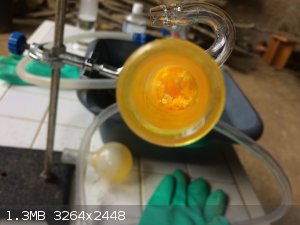
[Edited on 18-5-2021 by Keras]
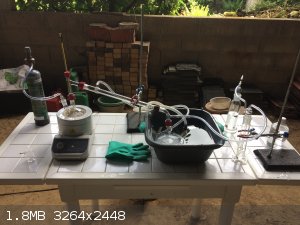
[Edited on 18-5-2021 by Keras]
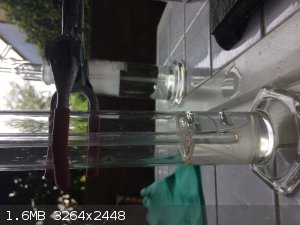
[Edited on 18-5-2021 by Keras]
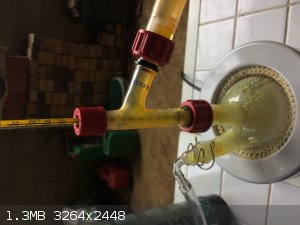
[Edited on 18-5-2021 by Keras]
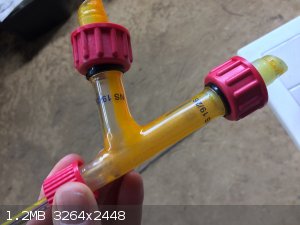
|
|
|
| Pages:
1
2 |